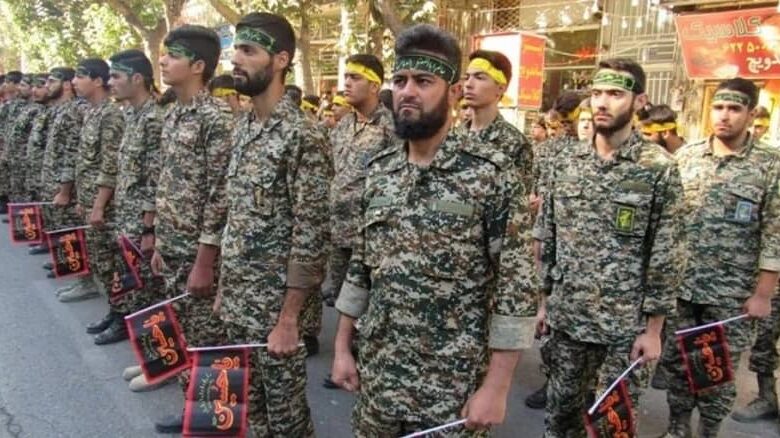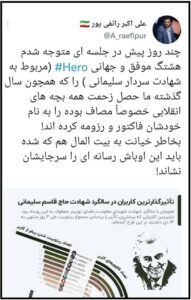Mysterious Death of Cyber Activist Raises Questions Amid Iran’s Political Turmoil

IRGC-patrols-1
Written by
Mehdi Oghbai
On October 2, Nima Keshvari, the administrator of a Telegram channel closely associated with the regime’s former president Hassan Rouhani, drowned in the Caspian Sea. Curiously, his demise went largely unnoticed, and the circumstances surrounding his death remained shrouded in mystery. No substantial information regarding the cause of death was disclosed either to Keshvari’s family or the media. While a few state-run media outlets did cover the incident, their coverage was superficial and lacked the necessary context. This hints at a potential limitation imposed by the Ministry of Guidance, underscoring the sensitive nature of the situation.
According to the state-affiliated Sharq newspaper, by mid-March 2017, Nima Keshvari and eight other administrators of Telegram channels were summoned by one of the country’s intelligence agencies. This move prompted protests from certain members of the parliament aligned with the so-called “reformist” faction.
Following a parliamentary inquiry of then-Minister of Intelligence (MOIS) Mahmoud Alavi, one of the MPs, Alireza Rahimi, wrote on Telegram, “The Minister of Intelligence declared that the ministry had no involvement in the detention and the case of these Telegram channel administrators and that another security organization had taken the lead in their arrest. He further added that he doesn’t find any justification for the charges against these admins and is not aware of the details regarding this matter.”
The situation gained further attention when then-President Hassan Rouhani weighed in on this matter, stating, “One method that has been employed, and we hope it will not be employed anymore, is the practice of arresting someone on Thursday when their summons is for the following Saturday, allowing them to spend a couple of nights behind bars, according to some. Just before the Eid holidays, some young individuals were arrested. I promptly requested a report from the Minister of Intelligence, and based on the information available, it appeared that these individuals had not committed any crimes.”
Iran’s Cyber Army: A Force of Disinformation for a Cursed Causehttps://t.co/S3LusEN4HB
— NCRI-FAC (@iran_policy) April 26, 2023
Lethal rivalry
Prominent figures from the Rouhani administration gathered at the funeral ceremony for Nima Keshvari, held at the Muslim Ibn Aqil Mosque in Yousef Abad. Notable attendees included former Minister of Intelligence Mahmoud Alavi and former presidential deputies such as Masoumeh Ebtekar, Jamshid Ansari, and Mohsen Mehr-Alizadeh, who had served as a deputy under Mohammad Khatami.
During the funeral, former MOIS Chief Alavi vehemently refuted allegations suggesting that the Rouhani government had provided funds and information to specific Telegram channels. He also criticized the individuals who had interrogated and pressured Nima Keshvari to confess that he had received payments from the Rouhani administration.
The suspicious circumstances surrounding Nima Keshvari’s death, along with the reactions of state media and officials, underscore a profound power struggle within the clerical regime. These internal conflicts reveal much about the ruling establishment and its deceptive narratives for domestic and international audiences.
Interior cyber war
On June 17, 2022, the official IRNA News Agency published a public announcement from the Intelligence Organization of the Islamic Revolutionary Guard Corps that reported on the arrest of three administrators of Telegram channels, such as “Akhabar-e-Nimeh Mahramaneh [Persian for semi-classified news], Saraer [Persian for secrets] and Sayenevis [Persian for shadow writer] for “publishing classified documents and disturbing public opinion.”
Among the charges, it was alleged that they attempted to gain their audience’s trust by releasing classified documents and then disseminating selective and false news to create divisions among the country’s officials.
One of the arrested individuals, Ali Qolhaki, was known as a media activist with connections to intelligence sources. While the specific reasons for their detention were not provided, one of the reports published by these Telegram channels discussed a verbal altercation between former nuclear negotiator Saeed Jalili and former Parliament Speaker Ali Larijani during a session of the Expediency Discernment Council. This session reportedly involved a proposal by Saeed Jalili for the regime’s withdrawal from the NPT (Non-Proliferation Treaty), which was opposed by Ali Larijani and former Chief Justice Sadegh Larijani.
Following Qolhaki’s arrest, some insiders within the regime expressed support for the IRGC’s decision and accused the arrested individuals of acting on behalf of the regime’s enemies.

iran raefipour post soleimani (1)In a revealing statement, Ali Akbar Raefipour, a media figure closely aligned with the regime’s Supreme Leader Ali Khamenei, revealed the regime’s disinformation tactics. He disclosed how specific cyber activists were being compensated for their involvement in the regime’s social media campaigns, stating, “The leader of this group is an aggressive project grabber, as I had previously cautioned.”
This reference harked back to his earlier warning, in which he stated, “A few days ago, I learned in a meeting that these media bandits took credit for the successful global hashtag #hero (related to General Soleimani’s martyrdom), which, like the previous year, was the result of the efforts of revolutionary youth, particularly Masaf [his own network]. These media thugs, for their betrayal of public assets, should face consequences.”
The intriguing aspect here lies not in the intense rivalry among various factions within the regime’s cyber army or the extent of its reach. Rather, it reveals a larger, unsettling picture of a regime that resorts to violent methods to manage internal power struggles.
As the state-run Ruydad 24 writes, “Numerous political activists are left pondering the motives of security institutions behind the publicizing of the arrest of these channel administrators. This raises further inquiries, for which we lack definitive answers. If inciting disputes among state officials is considered a crime, why weren’t these individuals, along with other official websites promoting this agenda, dealt with during President Rouhani’s eight-year tenure? Another question pertains to the influence of media associated with the Revolutionary Guards and whether the IRGC maintains an official presence on platforms like Telegram and Twitter. It appears that the arrests of these Telegram channel administrators followed a selective approach. Curiously, several channels on Telegram, whose administrators are even accused of extortion by conservatives, operate under the official banner of the Revolutionary Guards.”
As of the date of this report, there is no information available regarding the whereabouts of Ali Q olhaki, whose Twitter account, with over 80,000 followers, has been silent since June 10, 2022.
Ruhollah Mo'men Nasab, parliamentary special advisor on the so-called "internet users projection bill" and former commander of the cyber army reveals how #Tehran has been using @Twitter for #propaganda.
#Iran #InternetFreedom pic.twitter.com/kHzjtlEFvR— NCRI-FAC (@iran_policy) March 29, 2022
Conclusions drawn
A comprehensive report by the NCRI provides details on the intricate structure, tactics, and backgrounds of various organizations and institutions operating as the Iranian regime’s cyber army. The report highlights the story of one of its disgruntled founders, Mohammad-Hossein Tajik, who was ultimately threatened, abducted, and killed in 2016.
Amidst a complex web of domestic and international crises that threaten its hold on power, the clerical dictatorship has grown increasingly intolerant of dissent, defection, and even minor acts of whistleblowing. This heightened level of sensitivity highlights a significant vulnerability in their regime.
In this oppressive system, complicity has historically been the sole means to gain trust and leverage in positions of authority. Consequently, any genuine attempt to defect or expose the regime’s wrongdoings carries the potential to become an existential threat. This starkly underscores the regime’s inherent inability and unwillingness to reform. Thus, the only path forward is the removal of this dictatorship from Iran, transforming its crimes into lessons for history and a better world void thereof.
Mysterious Death of Cyber Activist Raises Questions Amid Iran’s Political Turmoil

